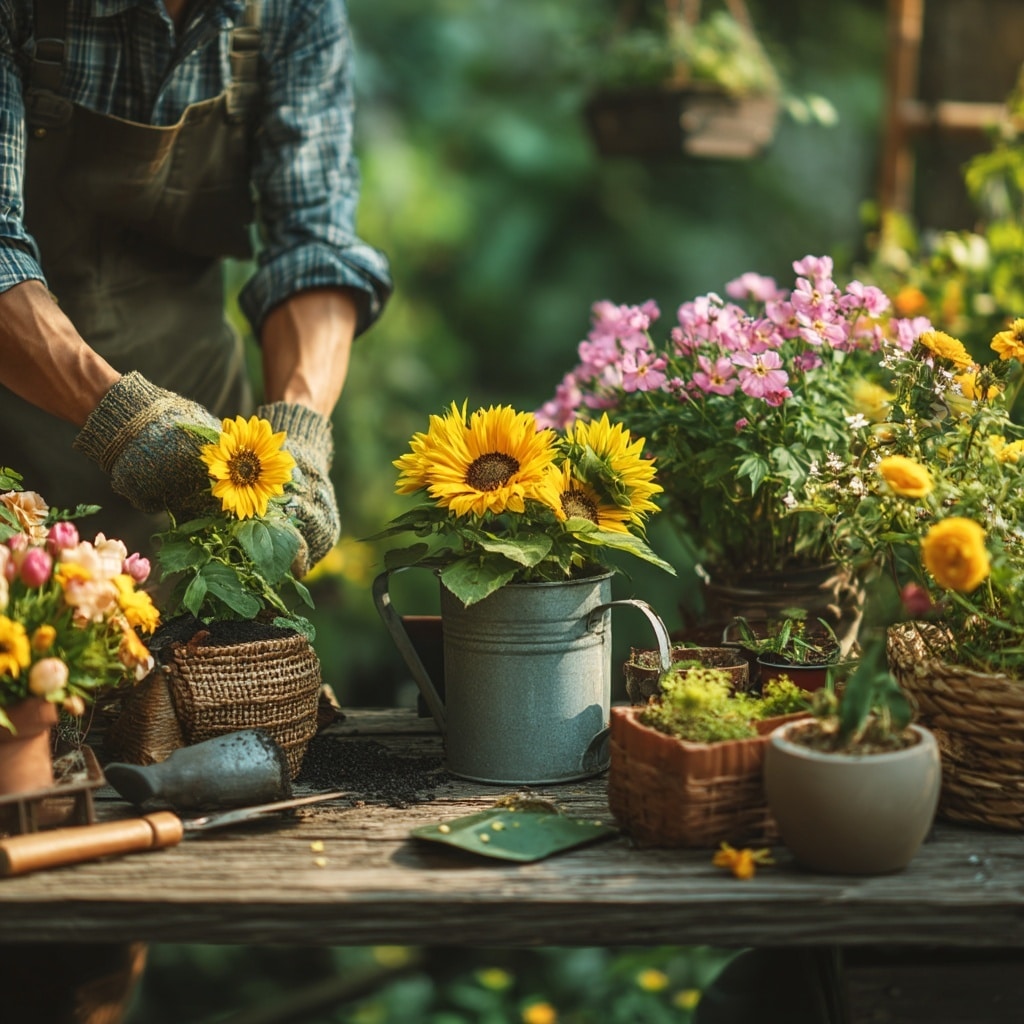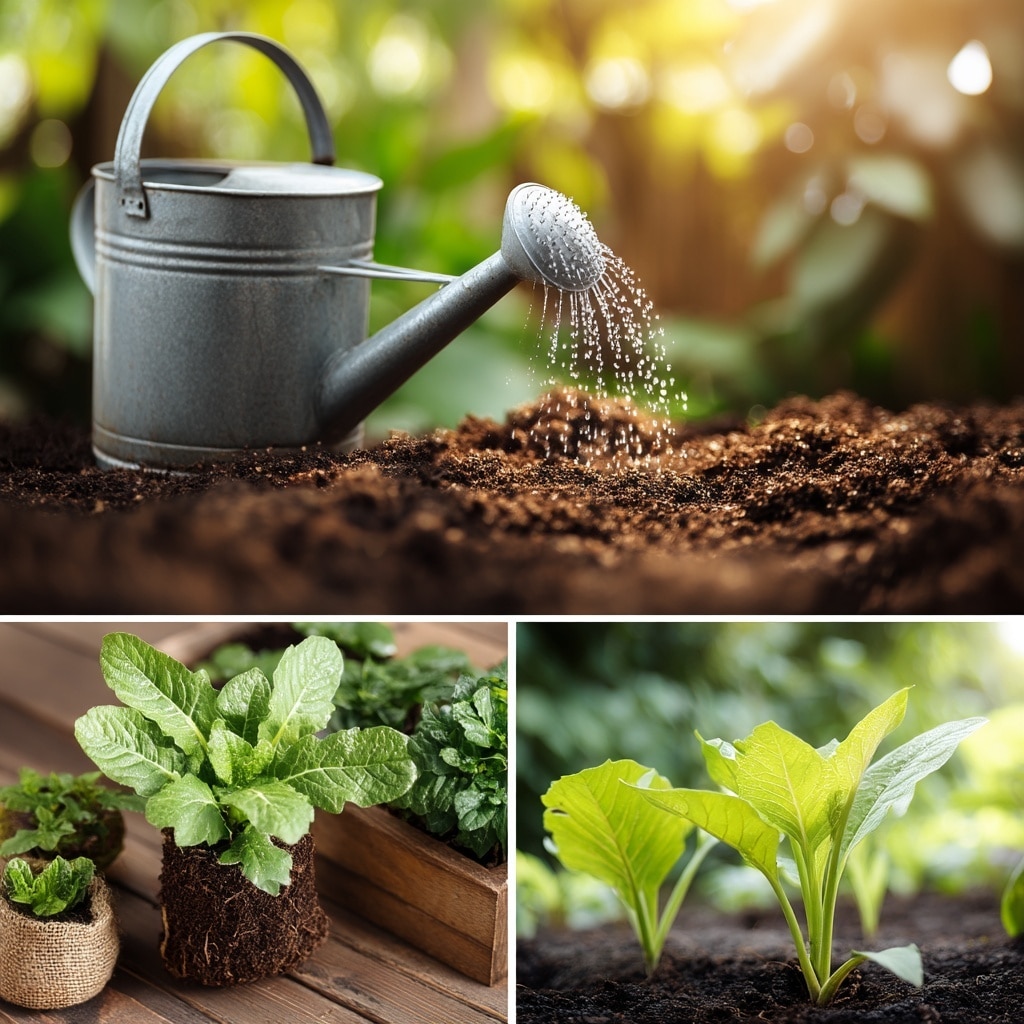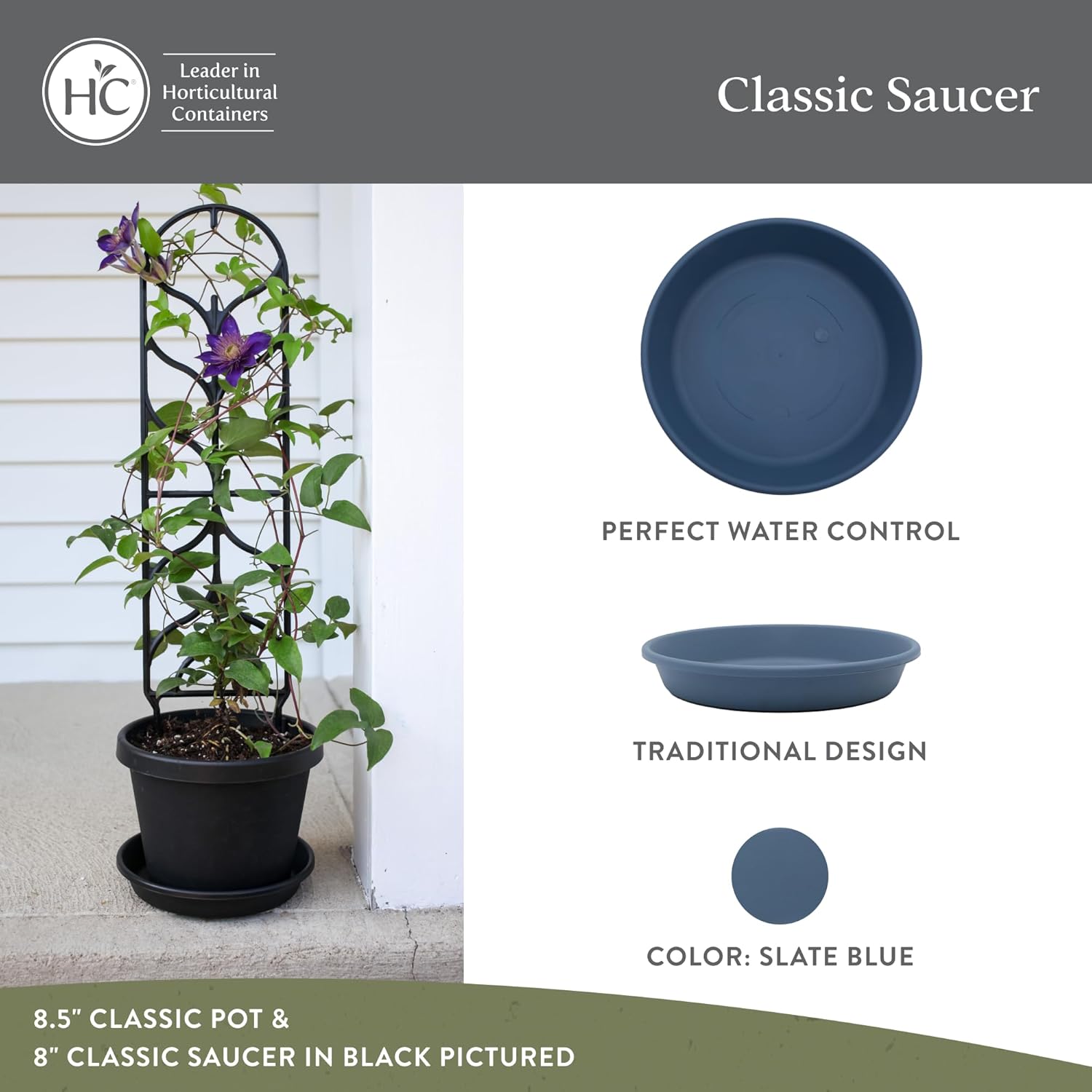Plant lovers around the world are drawn to the rich stories and stunning beauty of iconic species like roses, orchids, tulips, and sunflowers. These beloved plants are more than just decorative—they hold deep cultural meanings, have unique botanical features, and bring joy to both novice and seasoned gardeners alike.
From the spiritual symbolism of the lotus to the precise art of bonsai, each plant offers its own blend of history, care needs, and visual impact. Whether you’re growing them indoors or out, understanding what makes these plants thrive will help you cultivate not just a beautiful garden, but a healthier, more rewarding one.
In this guide, you’ll discover how to care for ten of the most famous plants in the world—each with tailored tips on sunlight, soil, watering, and common challenges. With a bit of attention and the right conditions, even the most exotic species can become a thriving part of your plant collection.
Table of Contents
General Plant Care Principles
While each plant has its quirks, a few core care principles apply across most species. Understanding these basics will help you prevent common mistakes and create a healthier growing environment for all the plants in your garden.
Soil Quality
Healthy soil is the backbone of every thriving plant. Most plants prefer well-draining soil that retains moisture without becoming soggy. If your soil feels compacted or drains poorly, consider mixing in compost, perlite, or aged manure to improve structure and fertility.
- Use organic matter to enrich the soil
- Avoid planting in areas with standing water
- Test pH if you’re unsure—many plants prefer slightly acidic to neutral soil (6.0–7.0)
Watering Practices
Overwatering is one of the most common ways to harm a plant. Before reaching for the watering can, always check the top inch of soil. If it still feels damp, wait a day or two. Underwatering, though less common, can also stress your plants, especially during hot or windy conditions.
- Water deeply and infrequently to encourage strong roots
- Avoid wetting the foliage to reduce disease risk
- Adjust frequency based on season, pot size, and plant type
Sunlight and Position
Light is essential to photosynthesis and overall plant health. While some plants tolerate shade, most need several hours of direct or filtered sunlight each day. Monitor how light moves through your space and adjust placement as needed.
- South-facing windows offer the most light indoors
- Outdoors, observe sun patterns before planting
- Rotate potted plants regularly for even growth
Fertilization
Fertilizers give plants a nutritional boost, but more isn’t always better. A balanced approach prevents nutrient burn and encourages steady growth.
- Use species-specific or general-purpose fertilizers (e.g., 10-10-10 NPK)
- Follow product directions carefully
- Reduce or stop feeding in fall and winter for dormant plants
Pest and Disease Management
A healthy plant is better equipped to resist pests and infections. Keep an eye out for yellowing leaves, webbing, sticky residue, or holes, which may signal early signs of trouble.
- Neem oil or insecticidal soap handles most minor infestations
- Remove dead or diseased plant material promptly
- Keep leaves dry and ensure airflow between plants to reduce fungal issues
1. Roses
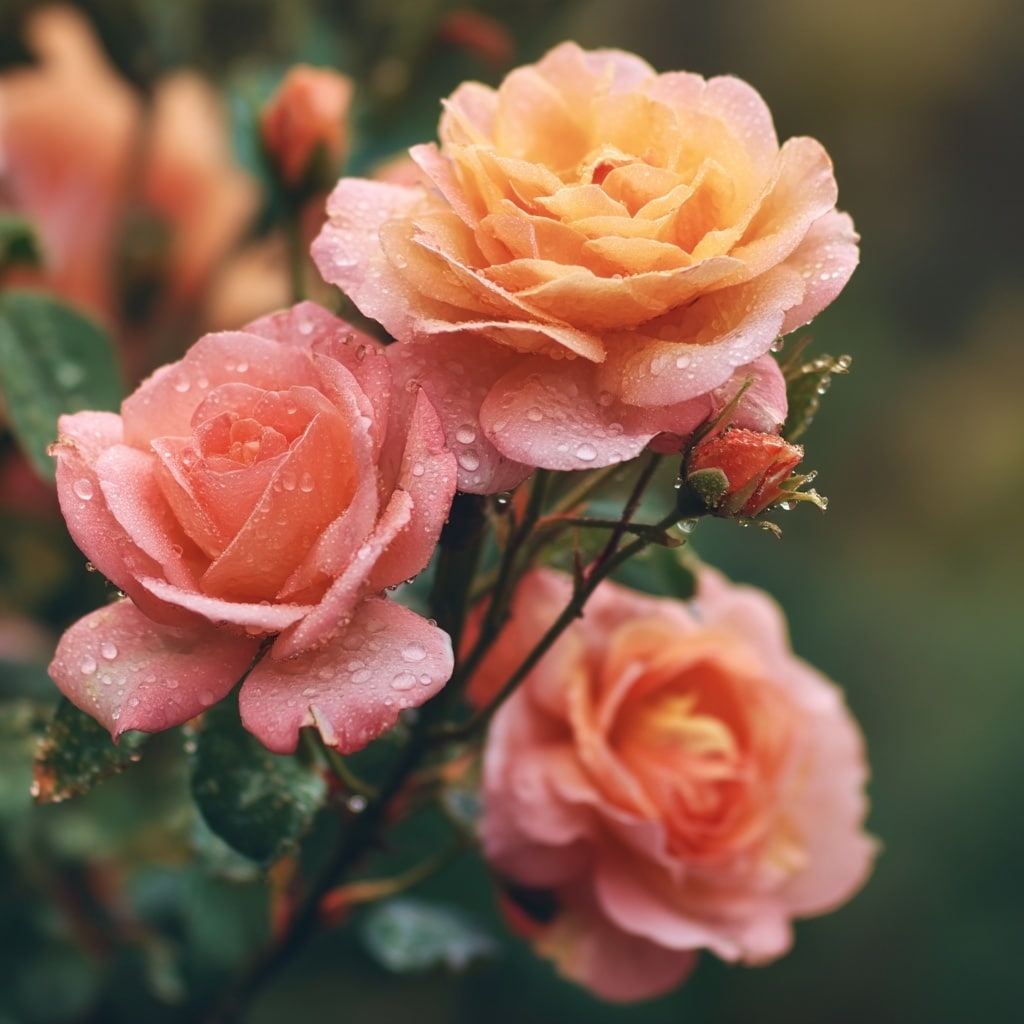
Background and Significance
No plant has been more universally adored than the rose. With a legacy rooted in ancient civilizations, roses have symbolized everything from love and beauty to secrecy and war. Today, they remain a beloved garden favorite, available in thousands of varieties that differ in size, color, and fragrance.
How to Care for Roses
Sunlight
Roses flourish with 6 to 8 hours of direct sunlight each day. Insufficient light can lead to fewer blooms and increased disease risk.
Soil and Planting
Choose soil that is slightly acidic (pH 6.0–6.5), rich in organic matter, and well-draining. If your soil is heavy or clay-like, amend it with compost or plant in raised beds.
Watering
Deep watering once or twice per week is better than frequent shallow watering. Soak the soil at the base and avoid overhead watering to reduce the risk of leaf diseases like black spot or powdery mildew.
Fertilization
Use a rose-specific fertilizer during the growing season—once in early spring, then again in midsummer. Stop fertilizing in late summer to avoid encouraging new growth before frost.
Pruning
Prune roses in late winter or very early spring. Remove dead or crossing branches and shape the plant to promote air circulation. Clean, angled cuts above outward-facing buds encourage healthy growth.
Common Problems
- Aphids: Treat with insecticidal soap or strong water sprays.
- Black spot & mildew: Prevent by spacing plants well and keeping leaves dry.
- Leggy growth: Often due to low light or lack of pruning.
Why They’re Famous
Roses are the epitome of romance and elegance. Found in everything from poetry to perfumes, their timeless appeal and sheer diversity have earned them a permanent place in gardens around the world.
2. Orchids
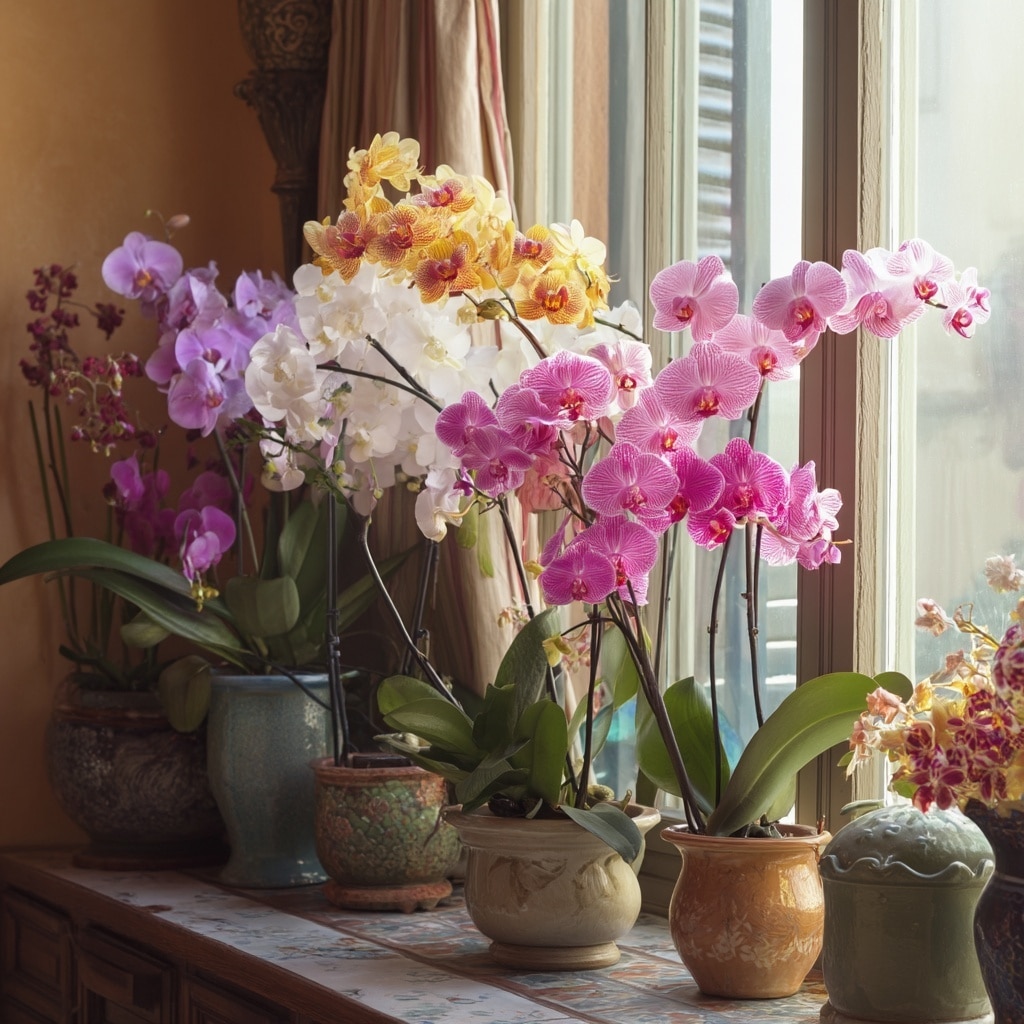
Background and Significance
Among the most exotic and diverse members of the plant kingdom, orchids have long symbolized luxury, refinement, and delicate beauty. With over 28,000 species and thousands more hybrids, orchids thrive across nearly every continent. From tropical rainforests to minimalist modern homes, they’re treasured for their unusual shapes and long-lasting blooms.
How to Care for Orchids
Light
Orchids prefer bright, indirect light. Harsh sun can scorch their leaves, while too little light prevents blooming. A spot near an east- or north-facing window is often ideal.
Water and Humidity
Orchids hate soggy roots. Use the “soak and dry” method: water once a week, let the excess drain fully, and allow the medium to dry slightly between waterings. Aim for 50%–70% humidity—a humidity tray or nearby humidifier can help, especially indoors.
Potting Medium
Skip standard soil. Instead, use a special orchid mix made of bark, sphagnum moss, charcoal, or perlite. This mimics the orchid’s natural habitat on trees, where roots need air circulation.
Temperature
Most orchids thrive in temperatures of 65°F to 80°F (18–27°C) during the day, with a 10°F drop at night. Avoid drafts or direct heat sources.
Fertilization
Use a balanced orchid fertilizer (like 20-20-20) at half strength every 2–3 weeks during active growth. Don’t fertilize during dormancy or when blooming slows down.
Encouraging Reblooming
Once blooms fade, cut the flower spike just above a visible node. With patience, many orchids (especially Phalaenopsis) will produce new shoots and bloom again within a few months.
Common Problems
- Root rot from overwatering or poor drainage
- No flowers due to insufficient light or overfeeding
- Wrinkled leaves indicate dehydration or root damage
Why They’re Famous
Orchids mesmerize with their intricate, often otherworldly flowers. Revered in cultures from Asia to South America, they represent rare beauty and are often passed down as heirloom plants—making them a prized part of any serious plant collection.
3. Tulips
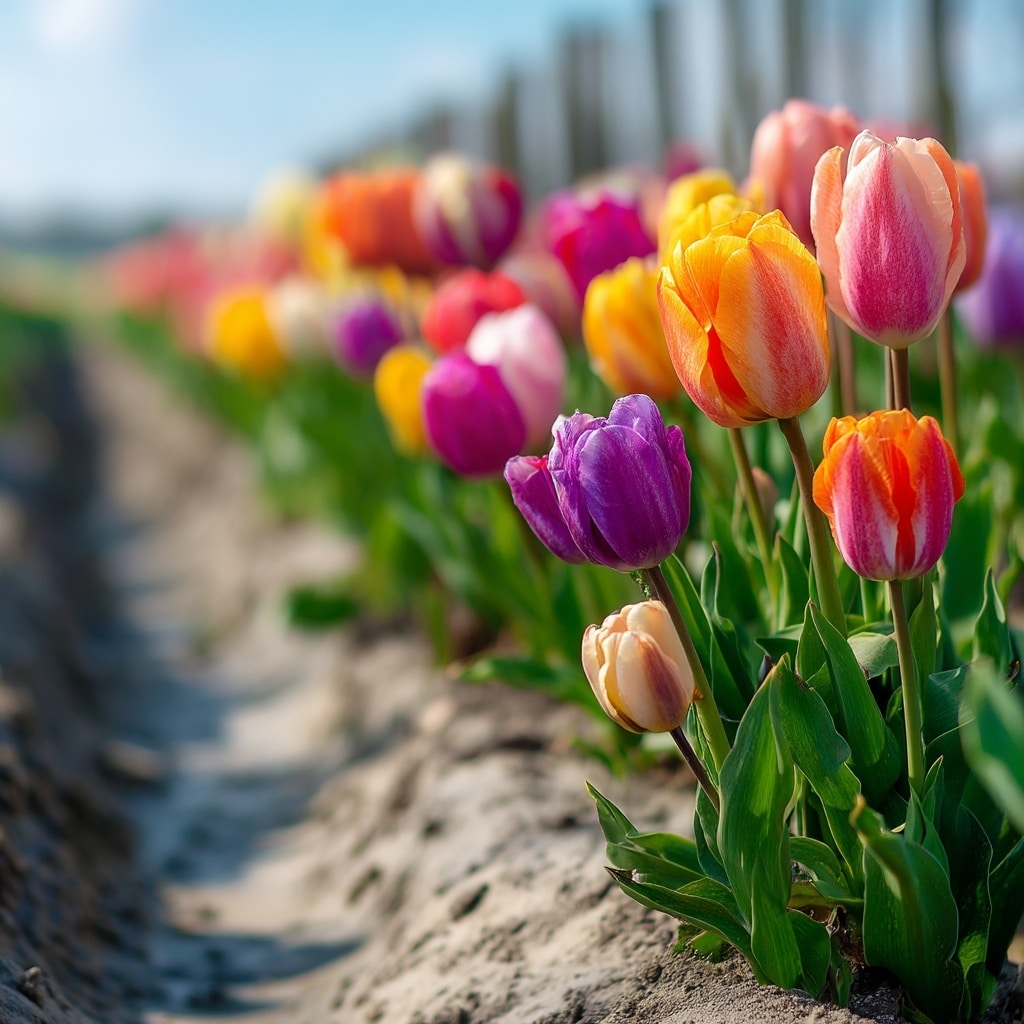
Background and Significance
Known for their bold, cup-shaped blooms, tulips have become a global symbol of spring. This plant traces its origins to Central Asia, but it was in 17th-century Holland that tulips sparked one of the world’s first speculative bubbles—Tulip Mania. Today, they continue to captivate gardeners with their rich colors, clean lines, and orderly beauty.
How to Care for Tulips
Planting Bulbs
Tulips grow from bulbs, which should be planted in early to mid-autumn, before the ground freezes. Choose a sunny location and plant bulbs 6–8 inches deep with the pointed end facing up. Space them about 4–6 inches apart for best results.
Soil Preferences
Tulips prefer well-draining, sandy or loamy soil with a neutral to slightly acidic pH (6.0–7.0). Avoid soggy areas that retain moisture, as the bulbs are prone to rot.
Watering
After planting, water deeply once. During their active spring growth, tulips typically require minimal additional watering unless the weather is very dry. Always allow the soil to dry between waterings.
Light and Temperature
Full sun (at least 6 hours daily) is essential for strong stems and vivid flowers. Tulips also require a cold dormant period—typically 12–16 weeks below 50°F (10°C)—to bloom successfully. This makes them ideal for planting in temperate climates.
Post-Bloom Care
Once the flowers fade, don’t cut the foliage immediately. Let it die back naturally, as this allows the bulb to store energy for the next season. Remove the spent flower heads to direct energy back into the bulb rather than seed production.
Common Problems
- Rotting bulbs due to overwatering or heavy soils
- Rodent damage: Squirrels and voles may dig up bulbs—try wire mesh or repellents
- Weak blooms after the first year: Tulips often decline in quality over time unless conditions are ideal
Why They’re Famous
From their royal origins in the Ottoman Empire to the sweeping tulip fields of the Netherlands, this elegant plant has captured hearts for centuries. Their predictable, striking bloom shapes and wide color range make them a spring garden staple.
4. Sunflowers
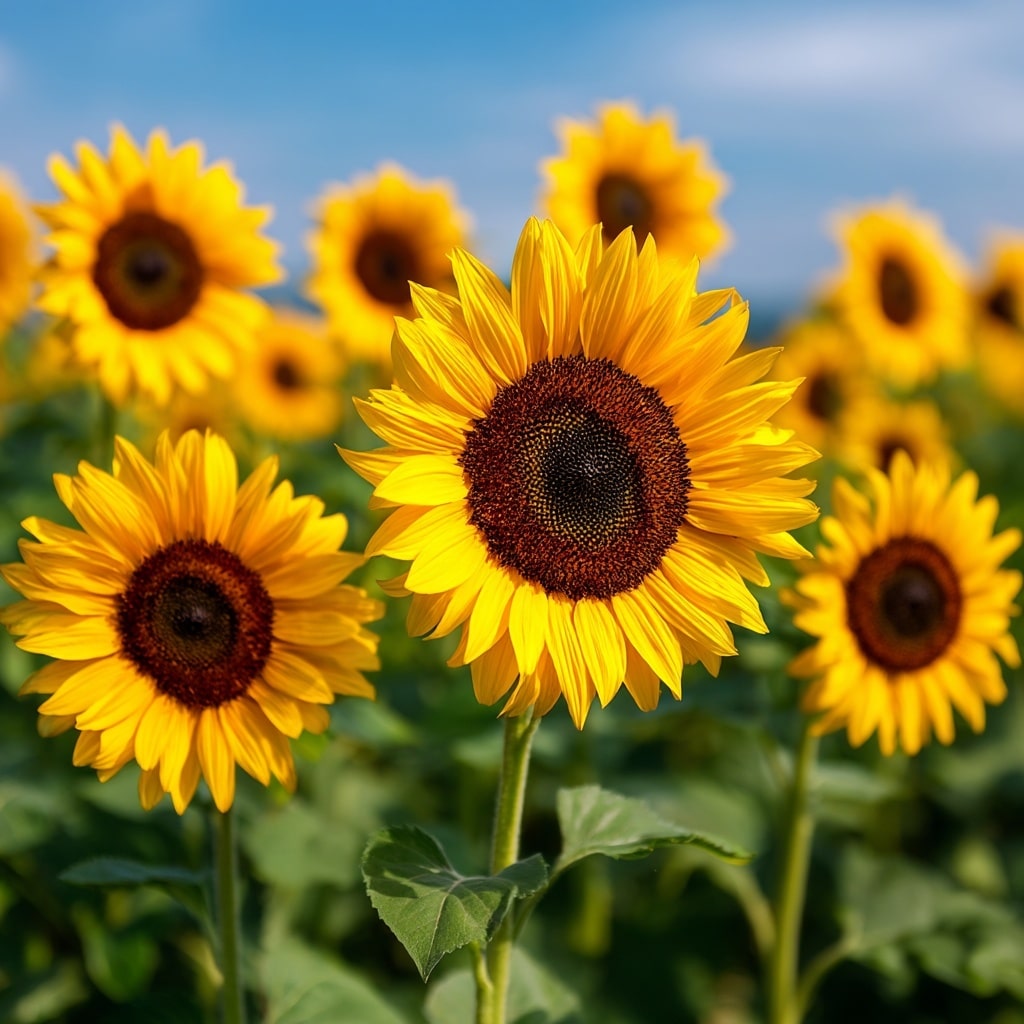
Background and Significance
There’s no mistaking the bright, cheerful face of a sunflower. Native to North America, this plant is admired for more than just its stunning appearance—it’s also an important crop for seeds, oil, and pollinator support. Sunflowers famously follow the sun in their early growth, a phenomenon known as heliotropism, adding movement and life to gardens and fields.
How to Care for Sunflowers
Sunlight
True to their name, sunflowers need full sun—at least 6–8 hours daily. A lack of sunlight can result in weak stems and small blooms.
Soil and Planting
Sow sunflower seeds directly outdoors after the last frost. Choose a location with loose, well-draining soil and a slightly acidic to neutral pH (6.0–7.5). Enrich the area with compost to support strong root development.
Watering
Keep the soil moist during germination and early growth. Once established, sunflowers become fairly drought-tolerant, but consistent watering helps produce larger blooms.
Fertilization
A general-purpose fertilizer (preferably low in nitrogen) applied early in the season promotes strong stems and flower formation. Excess nitrogen can cause lush leaves with few flowers.
Support
Taller varieties may need staking, especially in windy areas. Space plants about 12–24 inches apart to allow airflow and reduce competition for light.
Common Problems
- Birds and squirrels may steal seeds before harvest—use netting if necessary
- Powdery mildew or rust in humid conditions—promote airflow and avoid wetting leaves
- Drooping heads can result from insufficient water or very large flower heads—support may be needed
Why They’re Famous
Beyond their radiant looks, sunflowers have become symbols of joy, optimism, and resilience. Artists like Van Gogh immortalized them, and gardeners love their ease of care and towering impact. This iconic plant blends beauty with productivity, offering seeds for snacks or wildlife after the show is over.
5. Lavender

Background and Significance
Famous for its calming scent and beautiful purple blooms, lavender is more than just a fragrant herb—it’s a hardy, drought-tolerant plant that thrives in the right conditions. Native to the Mediterranean, lavender has been used for centuries in aromatherapy, medicine, and gardens for its soothing presence and pollinator-friendly flowers.
How to Care for Lavender
Sunlight
Lavender craves full sun—a minimum of 6 hours daily. The more light it receives, the more fragrant and abundant the blooms will be.
Soil
Good drainage is essential. Lavender prefers gritty, sandy soil with a slightly alkaline pH (around 7.0–7.5). Heavy or clay soil should be amended with coarse sand or gravel to avoid root rot.
Watering
Lavender is drought-tolerant once established. Water young plants regularly during their first growing season to encourage strong roots. After that, let the soil dry out completely between waterings. Overwatering is a common cause of failure.
Pruning
Prune once a year, typically after flowering, to prevent the plant from becoming woody and leggy. Cut back about one-third of the growth, but never into the woody base, as those stems may not regrow.
Fertilization
Lavender doesn’t require much feeding. A light application of compost in spring is usually sufficient. Avoid high-nitrogen fertilizers, which encourage foliage over flowers.
Harvesting and Use
Cut flower stems just before full bloom for drying. Dried lavender can be used in sachets, oils, teas, and even baked goods. Its scent also acts as a natural pest repellent.
Common Problems
- Root rot from poor drainage or excessive watering
- Lack of blooms due to insufficient light or over-fertilizing
- Leggy growth if not pruned annually
Why They’re Famous
Lavender has found a home in everything from ancient Roman baths to modern wellness products. Loved for its therapeutic fragrance, this resilient plant also brings a touch of Provence to any garden—and keeps bees and butterflies coming back all season long.
6. Bonsai

Background and Significance
Unlike other entries on this list, bonsai isn’t a species—it’s a living art form. The word bonsai means “planted in a container,” and the goal is to create a miniature, lifelike version of a full-sized tree. While any tree or shrub can potentially be trained as a bonsai, this plant practice originated in China and was refined over centuries in Japan. It represents harmony, discipline, and a deep relationship between gardener and plant.
How to Care for Bonsai
Species Selection
Common bonsai trees include juniper, ficus, maple, elm, and pine. Some are better suited to beginners than others. Indoor bonsai typically include tropical species like Ficus, while temperate trees like maple or juniper need seasonal outdoor exposure and winter dormancy.
Soil and Containers
Bonsai trees need fast-draining soil to prevent water buildup in their shallow pots. A mix of akadama (clay), pumice, and lava rock provides aeration and retains just enough moisture. Bonsai containers are wide and shallow, helping to limit root growth and support the miniature size.
Watering
Check daily—bonsai trees dry out quickly. Water when the soil feels slightly dry, and ensure full saturation. Avoid letting the soil stay soggy or dry out completely. The type of plant, container, and climate all affect watering frequency.
Pruning and Shaping
This is the heart of bonsai care. Prune roots, branches, and leaves regularly to maintain the desired shape. Wiring helps guide branch direction, while root pruning keeps the tree balanced in its container. This process requires precision and patience.
Fertilization
Since soil volume is limited, bonsai trees need frequent but light feeding during the growing season. Use a balanced, slow-release fertilizer or dilute liquid feed every 2–4 weeks. Avoid fertilizing during winter dormancy for deciduous species.
Common Problems
- Underwatering is common due to the small pot size
- Root rot from poor drainage
- Pests like spider mites or scale insects, especially indoors
- Weak growth from lack of nutrients or poor light
Why They’re Famous
Bonsai is much more than growing a plant—it’s a meditative craft rooted in tradition. Each tree tells a story, shaped over years or even decades. It’s a reflection of nature’s power, carefully balanced in miniature, and cherished as a living sculpture across cultures.
7. Bamboo

Background and Significance
Known for its strength, speed, and symbolism, bamboo is a fascinating plant that bridges utility and beauty. While technically a fast-growing grass, bamboo behaves like a tree—shooting up rapidly and reaching impressive heights. In many Asian cultures, it represents resilience, flexibility, and good fortune. In the garden, bamboo adds vertical interest, natural screening, and a touch of the exotic.
How to Care for Bamboo
Species Selection
There are two main types of bamboo:
- Clumping bamboo: Spreads slowly and is easier to manage
- Running bamboo: Grows aggressively through underground rhizomes and needs containment
Choose a species suited to your space. For smaller gardens or containers, clumping varieties are usually the best choice.
Sunlight
Most bamboo plants prefer full sun to partial shade. Some tropical species tolerate more shade, but for strong, upright growth, aim for 5–6 hours of sunlight daily.
Soil and Watering
Bamboo thrives in loamy, well-drained soil that retains some moisture. Keep the soil consistently damp during the first growing season. Once established, most varieties are drought-tolerant, though they still benefit from occasional deep watering.
Container Growing
To prevent spreading, plant bamboo in large containers or use rhizome barriers underground. Container bamboo dries out faster and will need more frequent watering and feeding.
Fertilization
Feed bamboo in spring and midsummer with a nitrogen-rich fertilizer (like a lawn formula). This encourages lush foliage and rapid vertical growth.
Pruning and Maintenance
Remove dead or weak canes annually to maintain the plant’s appearance and health. Thin out the clump to increase airflow and sunlight penetration.
Common Problems
- Invasive spreading from running types—install physical barriers or grow in pots
- Leaf yellowing from nutrient deficiencies or poor drainage
- Fungal spots in overly humid or wet conditions—prune for better airflow
Why They’re Famous
Bamboo’s fast growth, strength, and versatility have made it a staple in everything from architecture to paper. As a plant, it’s admired for its elegant form and soothing rustle in the wind. With proper management, it brings texture and structure to landscapes—and even a bit of luck to your home.
8. Cacti
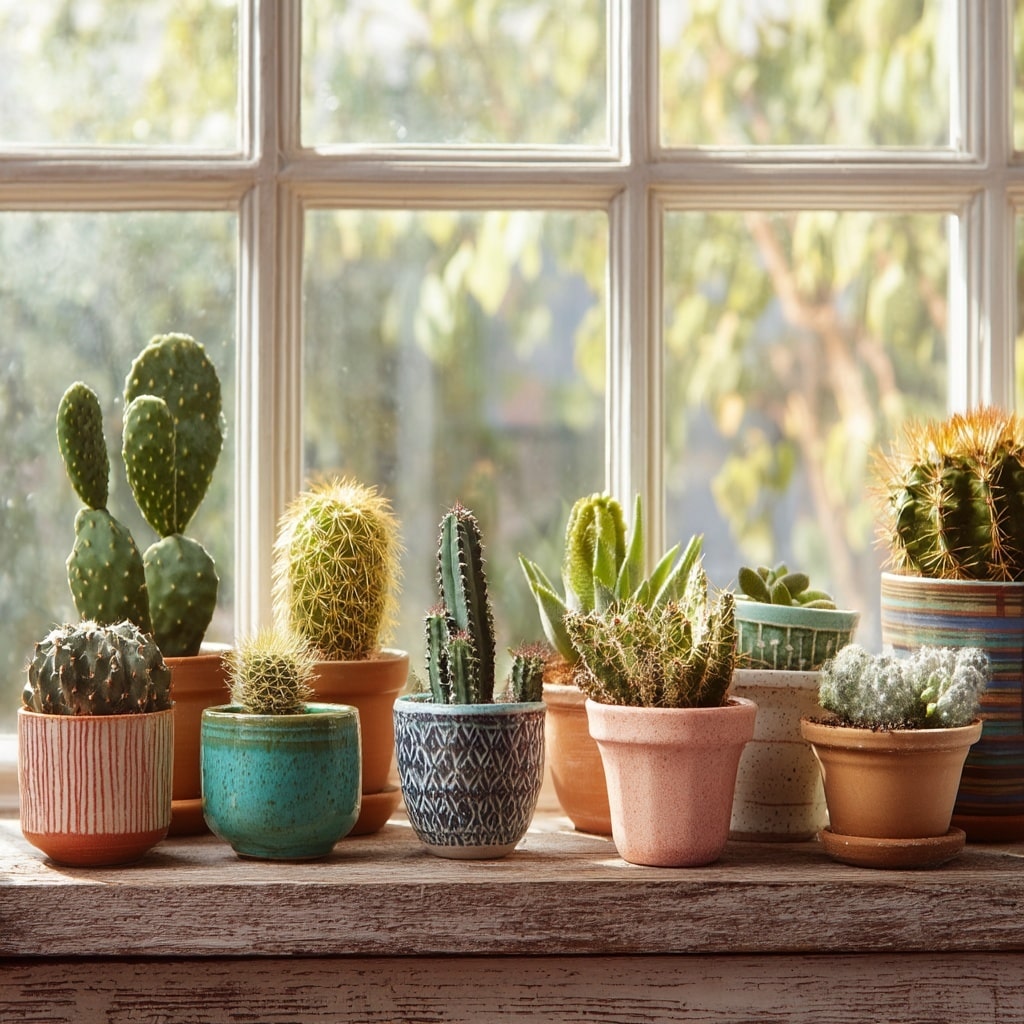
Background and Significance
Cacti are the ultimate survivors of the plant world. With their thick, spiny skins and impressive ability to store water, they’ve adapted to some of the harshest environments on Earth. From towering saguaros in the Sonoran Desert to compact species that fit on your windowsill, cacti are both striking and surprisingly low-maintenance. They symbolize endurance, protection, and quiet strength.
How to Care for Cacti
Light
Most cacti thrive in bright, direct sunlight. A south-facing window or sun-drenched patio is ideal. If your cactus starts leaning or turning pale, it’s likely not getting enough light.
Soil
Use a well-draining cactus or succulent mix—often containing sand, perlite, or pumice. Regular potting soil retains too much moisture and can lead to root rot.
Watering
Cacti prefer the “soak and dry” method. Water thoroughly, then wait until the soil is completely dry before watering again. During winter, most cacti go dormant and require very little moisture—sometimes just once a month.
Containers
If growing in pots, make sure the container has drainage holes. Terracotta pots are ideal as they allow excess moisture to evaporate.
Temperature
Cacti enjoy warm temperatures ranging from 65°F to 85°F (18–29°C). Some varieties tolerate near-freezing nights but generally dislike extended cold or frost exposure.
Fertilization
Feed sparingly. A low-nitrogen cactus fertilizer once a month during the growing season (spring and summer) supports healthy growth and blooming.
Common Problems
- Root rot from overwatering—this is the most common cause of death
- Mealybugs or spider mites can infest weakened plants—treat with neem oil or insecticidal soap
- Sunburn from sudden exposure to strong light—acclimate gradually when moving outdoors
Why They’re Famous
Cacti have captivated collectors, artists, and gardeners with their bizarre shapes, sculptural appeal, and colorful (though often rare) blooms. As a plant, they require minimal care, making them perfect for beginners, travelers, or anyone drawn to their quiet but bold presence.
9. Lotus

Background and Significance
The lotus is more than just a beautiful water flower—it’s a powerful spiritual symbol in many cultures. Revered in Buddhism and Hinduism, the lotus represents purity, rebirth, and inner peace, as it rises clean and radiant from murky waters. As a plant, it adds serenity and elegance to ponds, water gardens, and large containers with its broad leaves and striking blooms.
How to Care for Lotus
Planting
Lotus grows from rhizomes, not seeds. Plant rhizomes in wide, shallow containers filled with heavy loam or aquatic soil. Avoid using potting mix, which floats and clouds the water. Submerge the container so that 2–4 inches of water sit above the soil surface.
Sunlight
Lotus needs full sun—a minimum of 6 hours daily—to bloom. Without enough light, the plant will produce leaves but no flowers.
Water Conditions
Lotus prefers still, warm water. Avoid placing it near fountains, filters, or strong currents. In early spring, allow the water to warm before submerging the container completely.
Temperature and Climate
This is a heat-loving plant. Lotus thrives when water temperatures stay above 70°F (21°C). In colder zones, the plant may go dormant over winter—move it deeper in the pond or into a frost-free garage to protect the rhizomes.
Fertilization
Use a slow-release aquatic fertilizer once the plant starts actively growing. Stop feeding in late summer as it prepares to go dormant.
Maintenance
Remove yellow or decaying leaves regularly to maintain water clarity and prevent rot. Divide rhizomes every few years in spring to prevent overcrowding and promote healthier growth.
Common Problems
- No blooms due to lack of sunlight or insufficient warmth
- Algae growth in nutrient-rich water—shade from lotus leaves often helps
- Leaf burn from fertilizer pellets placed too close to roots
Why They’re Famous
The lotus is celebrated for its symbolic meaning and ethereal beauty. With flowers that bloom above the water’s surface, this remarkable plant reminds us that even in less-than-perfect conditions, beauty and resilience can rise. It brings both visual and spiritual tranquility to any water garden.
10. Carnivorous Plants
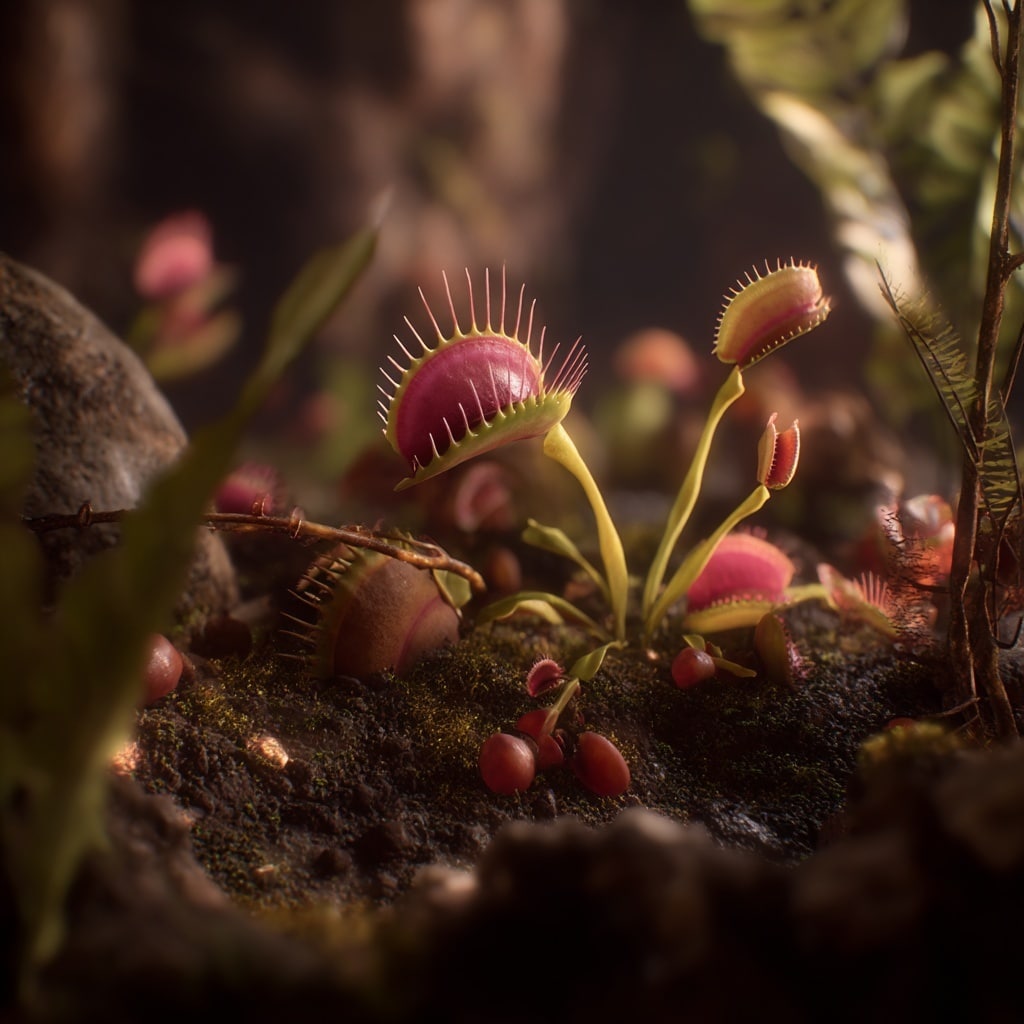
Background and Significance
Carnivorous plants are nature’s rule-breakers—fascinating species that have evolved to trap and digest insects for nutrients. Found in boggy, nutrient-poor habitats, these unique organisms challenge everything we think we know about the plant kingdom. Species like the Venus flytrap, pitcher plants, and sundews are not only curious conversation pieces but also rewarding to grow with the right care.
How to Care for Carnivorous Plants
Light
Most carnivorous plants need bright light to thrive. Venus flytraps and North American pitcher plants prefer full sun (6+ hours daily). Sundews and tropical varieties may tolerate bright, indirect light.
Water
Use only distilled, reverse-osmosis, or rainwater. Tap water contains minerals that can damage or kill these sensitive plants. Keep soil consistently moist but not soggy—many species do best sitting in a shallow tray of water.
Soil
These plants require nutrient-poor soil, typically a 1:1 mix of peat moss and perlite or sand. Never use potting soil, compost, or fertilizer, which can burn their delicate roots.
Humidity
Carnivorous plants generally prefer humid environments. A terrarium or pebble tray can help maintain moisture levels indoors, especially in dry climates or winter heating.
Feeding
If grown outdoors, they’ll often catch their own food. Indoors, feed with small, live insects (like fruit flies) once every week or two. Never feed them meat or human food. Venus flytraps should only be fed when the trap is open and healthy.
Dormancy
Temperate species like Venus flytraps and Sarracenia require a winter dormancy period—around 3 months of cool temperatures (35–50°F or 2–10°C). Reduce watering and provide a rest period to keep the plant healthy long-term.
Common Problems
- Mineral buildup from improper water
- Mold or fungus gnats in overly wet environments
- Trap failure from overfeeding or triggering traps too often for fun
Why They’re Famous
No other plant captures the imagination like a carnivorous one. With alien-like forms and bizarre feeding habits, they’ve inspired books, movies, and endless fascination. Growing one is like caring for a little predator—beautiful, strange, and surprisingly sensitive.
Putting It All Together

After learning about these ten remarkable species, it’s clear that no two plants are exactly alike. But by tuning into your growing conditions and paying attention to each plant’s natural preferences, you can create a garden that not only thrives—but tells a global story of beauty, symbolism, and care.
Match the Right Plant to the Right Place
A cactus won’t survive in a damp bathroom, and a lotus won’t bloom on a dry balcony. Assess the light, space, temperature, and moisture of your growing environment before introducing a new plant. Matching conditions to needs is the key to long-term success.
Embrace Each Plant’s Uniqueness
From orchids that bloom once a year to bonsai that need decades of shaping, every plant has a different rhythm. Avoid “one-size-fits-all” advice. Instead, learn a little about where the plant comes from and how it grows in the wild.
Observe and Respond
A plant’s leaves, color, and posture are its way of communicating. Drooping, yellowing, or stunted growth is a clue. Take a few minutes each week to inspect your plants—early detection prevents major issues.
Combine Function and Beauty
Choose plants that do more than just look good. Lavender repels pests. Bamboo makes a natural privacy screen. Sunflowers feed birds. Integrating plants with purpose can make your garden more self-sustaining and satisfying.
Don’t Stop Learning
Gardening is not about perfection—it’s about practice. Even seasoned growers lose plants sometimes. Whether you’re trying carnivorous plants for the first time or exploring the art of bonsai, each step adds to your experience and intuition.
Quick Recap: 10 Famous Plants and Their Key Needs
Here’s a summary of how to care for the world’s most iconic plants:
- Roses: Thrive in full sun, rich soil, and need regular pruning for repeat blooms.
- Orchids: Prefer bright, indirect light, bark-based medium, and high humidity.
- Tulips: Need a cold dormant period, well-draining soil, and minimal spring watering.
- Sunflowers: Love direct sun, loose soil, and consistent moisture during early growth.
- Lavender: Requires full sun, dry, sandy soil, and minimal watering once established.
- Bonsai: An art form requiring shallow pots, frequent pruning, and patient care.
- Bamboo: Fast-growing and elegant—needs sun, containment, and moist, rich soil.
- Cacti: Need full sun, sandy soil, and the soak-and-dry watering method.
- Lotus: Grows in warm, still water with full sun and heavy soil in shallow containers.
- Carnivorous Plants: Need distilled water, poor soil, bright light, and zero fertilizer.
Conclusion
Whether you’re caring for a single orchid or curating a full garden of symbolic flora, each plant on this list offers more than beauty—it brings history, culture, and personal reward. With the right balance of attention and environment, even the most exotic species can flourish in your care.
Let your garden reflect your curiosity, patience, and passion. Grow boldly—and your plants will reward you in kind.

